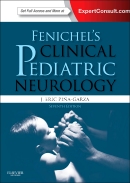 Book Review: Fenichel’s Clinical Pediatric Neurology: A Signs and Systems Approach, 7th edition
Book Review: Fenichel’s Clinical Pediatric Neurology: A Signs and Systems Approach, 7th edition
Author: J. Eric Pina-Garza
Publisher: Elsevier Saunders
Book Review by: Nano Khilnani
With this book, you get access to a whole lot of resources on www.ExpertConsult.com
Go to the inside front cover of this book, then scratch off the label to get your Activation Code.
If you are already a registered user at that site, enter the Activation Code in the Add a Title box. Then click Activate Now. Then click the title under My Titles.
If you arte a first-time user, click on Register Now at ExpertConsult.com, fill in your user information and click Continue. To activate your book’s online resources, enter the Activation Code into the Enter Activation Code box, click on Activate Now, and then finally click the title under My Titles.
The material you will find on the website highlighted above can be accessed through any Internet-ready device such as a desktop computer, laptop, or even a Smart phone. The information relating to this textbook is not only mobile and searchable, but is in addition to what is found in the print version of this title.
This is a volume with information for physicians who care for children with neurological disease. The following three aspects of such a practice are looked upon in this book:
• Guidelines
• Standards of practice
• Evidence-based medicine
This book contains 18 chapters. To give you a brief overview its contents, these are the titles of the chapters:
1. Paroxysmal Disorders
2. Altered States of Consciousness
3. Headache
4. Increased Intracranial Pressure
5. Psychomotor Retardation and Regression
6. The Hypotonic Infant
7. Flaccid Limb Weakness in Childhood
8. Cramps, Muscle Stiffness, and Exercise Intolerance
9. Sensory and Autonomic Disturbances
10. Ataxia
11. Hemiplegia
12. Paraplegia and Quadriplegia
13. Monoplegia
14. Movement Disorders
15. Disorders of Ocular Motility
16. Disorders of the Visual System
17. Lower Brainstem and Cranial Nerve Dysfunction
18. Disorders of Cranial Volume and Shame
Chapter organization is simple. A brief overview of contents is laid out with a beginning paragraph, followed by topic headings and discussions. In some cases, sub-headings are discussed.
Ample use of blue-background boxes enables the reader to snap up small packets of information and retain them in the brain for quick recall. Extensive lists of books on various topics are presented at the end of each chapter as References for the reader to look up and study other aspects of the chapter topic.
J. Eric Pina-Garza, MD is Associate Professor of Neurology, Director of Pediatric Neurology, and Director of Pediatric Epilepsy and the EEG Lab at the Monroe Carrell Jr. Children’s Hospital at Vanderbilt University in Nashville, Tennessee.






